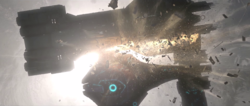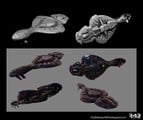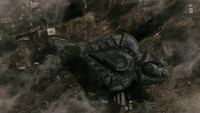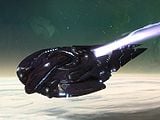Nanolaminate: Difference between revisions
From Halopedia, the Halo wiki
No edit summary |
(While our articles clearly indicate it's pretty much the only form of plating the Covenant use, it's better not to make too specific claims here.) |
||
| Line 1: | Line 1: | ||
{{Era|Covenant|Human|UNSC|HCW|Post}} | {{Era|Covenant|Human|UNSC|HCW|Post}} | ||
[[File:H4 Prologue CAS Carrier.jpg|thumb|290px|Nanolaminate plating provides both the aesthetic and protective functions of the [[Covenant]].]] | [[File:H4 Prologue CAS Carrier.jpg|thumb|290px|Nanolaminate plating provides both the aesthetic and protective functions of the [[Covenant]].]] | ||
'''Nanolaminate hull plating''' is | '''Nanolaminate hull plating''' is a form of battle plating found on the [[Covenant]]'s warships.<ref name="Catalog">[https://forums.halowaypoint.com/yaf_postsm2969315_Catalog-Interaction.aspx#post2969315 '''Halo Waypoint''': ''Catalog Interaction - Page 14'']</ref> It is typically purplish in color, although the {{Class|CAS|assault carrier}} has a pale white-blue hull and [[Kig-Yar]] vessels are generally bluish-black in color.<ref>'''[[Halo: Contact Harvest]]''', ''page 26''</ref> Nanolaminate plating was noted for causing the hulls of Covenant vessels to possess an odd, opalescent-like shine.<ref>'''[[Halo: The Fall of Reach]]''', ''page 119''</ref> The plating is very strong and heat resistant, with the support of [[energy shielding]] allowing Covenant ships to take more damage.<ref name="fs79">'''[[Halo: First Strike]]''', ''page 79''</ref> The amount of nanolaminate plating applied to each ship depends on the class, though {{Class|CSO|supercarrier}}s have well over thirty meters of armor plating.<ref>'''Halo: First Strike''', ''page 266''</ref> As of [[2525]], nanolaminate plating is not used in any [[human]] construction.<ref>'''Halo: Contact Harvest''', ''page 176''</ref> | ||
It is likely that Covenant [[dropship]]s, such as the [[Type-52 Phantom]], or assault platforms, such as the [[Type-47 Scarab]], are covered with nanolaminate hull plating. | It is likely that Covenant [[dropship]]s, such as the [[Type-52 Phantom]], or assault platforms, such as the [[Type-47 Scarab]], are covered with nanolaminate hull plating. | ||
| Line 10: | Line 10: | ||
The hull plating allows ships to be resilient to most [[UNSC]] weaponry. UNSC [[point-defense gun]]s are not powerful enough to do significant damage to the plating,<ref>'''Halo: The Fall of Reach''', ''page 272''</ref> [[Archer missile]]s prove to be very effective against the unshielded hull of a Covenant vessel causing the ship to become very vulnerable following the resulting explosions of the missiles.<ref>'''Halo: The Fall of Reach''', ''page 179''</ref> [[Magnetic Accelerator Cannon]]s are often used to disable and destroy Covenant vessels after the energy shielding fails, being powerful enough to pierce the nanolaminate hull plating of most ships with a single round.<ref>'''Halo: The Fall of Reach''', ''page 297''</ref> A single pack of [[C-12 shaped charge]]s can easily puncture a large hole through the hull of a [[Covenant cruiser]].<ref>'''[[Halo: Evolutions - Essential Tales of the Halo Universe]]''', "[[Blunt Instruments]]", ''page 202''</ref> A Covenant cruiser is capable of taking a direct hit from a [[mass driver]] at near point-blank range with only minor structural damage done to the nanolaminate plating, but a second hit in the same spot was capable of piercing the vessel.<ref>'''Halo: Contact Harvest''', ''page 342''</ref> | The hull plating allows ships to be resilient to most [[UNSC]] weaponry. UNSC [[point-defense gun]]s are not powerful enough to do significant damage to the plating,<ref>'''Halo: The Fall of Reach''', ''page 272''</ref> [[Archer missile]]s prove to be very effective against the unshielded hull of a Covenant vessel causing the ship to become very vulnerable following the resulting explosions of the missiles.<ref>'''Halo: The Fall of Reach''', ''page 179''</ref> [[Magnetic Accelerator Cannon]]s are often used to disable and destroy Covenant vessels after the energy shielding fails, being powerful enough to pierce the nanolaminate hull plating of most ships with a single round.<ref>'''Halo: The Fall of Reach''', ''page 297''</ref> A single pack of [[C-12 shaped charge]]s can easily puncture a large hole through the hull of a [[Covenant cruiser]].<ref>'''[[Halo: Evolutions - Essential Tales of the Halo Universe]]''', "[[Blunt Instruments]]", ''page 202''</ref> A Covenant cruiser is capable of taking a direct hit from a [[mass driver]] at near point-blank range with only minor structural damage done to the nanolaminate plating, but a second hit in the same spot was capable of piercing the vessel.<ref>'''Halo: Contact Harvest''', ''page 342''</ref> | ||
However, Covenant weaponry is more effective against nanolaminate plating. The ''CSO''-class supercarrier ''[[Ascendant Justice]]'', one of the most powerful vessels in the [[Covenant fleet]], was heavily damaged by a single [[plasma turret]] | However, Covenant weaponry is more effective against nanolaminate plating. The ''CSO''-class supercarrier ''[[Ascendant Justice]]'', one of the most powerful vessels in the [[Covenant fleet]], was heavily damaged by a single [[plasma turret|plasma torpedo]], with several layers of the armor plating boiling away.<ref>'''Halo: First Strike''', ''page 76''</ref> | ||
The nanolaminate plating is also durable against direct collisions with other vessels. [[Unidentified CPV-class heavy destroyer|A ''CPV''-class heavy destroyer]] took negligible damages after a direct collision with the {{UNSCShip|Spirit of Fire}}, with its energy shields seemingly not active.<ref>'''[[Halo Wars]]''', campaign level, ''[[ | The nanolaminate plating is also durable against direct collisions with other vessels. [[Unidentified CPV-class heavy destroyer|A ''CPV''-class heavy destroyer]] took negligible damages after a direct collision with the {{UNSCShip|Spirit of Fire}}, with its energy shields seemingly not active.<ref>'''[[Halo Wars]]''', campaign level, ''[[Repairs]]''</ref> Although during the [[Second Battle of Requiem]], a {{Class|RCS|armored cruiser}} equipped with energy shields, one of the former Covenant's most armored vessels, was obliterated after it endured a collision with the {{UNSCShip|Infinity}}, with seemingly no damage done to the ''Infinity''.<ref>'''[[Halo 4]]''', ''[[Departure]]''</ref> | ||
The Sangheili continued to improve their ships' nanolaminate plating and other onboard technologies in the wake of the Human-Covenant War. Following a joint anti-[[piracy]] operation with the [[UNSC Navy]] in a [[Joint Occupation Zone]] in [[2557]], [[ONI]] analysis noted improvements to the hull plating of the assault carrier ''[[Shadow of Intent]]''.<ref name="Catalog"/> | The Sangheili continued to improve their ships' nanolaminate plating and other onboard technologies in the wake of the Human-Covenant War. Following a joint anti-[[piracy]] operation with the [[UNSC Navy]] in a [[Joint Occupation Zone]] in [[2557]], [[ONI]] analysis noted improvements to the hull plating of the assault carrier ''[[Shadow of Intent]]''.<ref name="Catalog"/> | ||
Revision as of 12:44, August 20, 2014

Nanolaminate hull plating is a form of battle plating found on the Covenant's warships.[1] It is typically purplish in color, although the CAS-class assault carrier has a pale white-blue hull and Kig-Yar vessels are generally bluish-black in color.[2] Nanolaminate plating was noted for causing the hulls of Covenant vessels to possess an odd, opalescent-like shine.[3] The plating is very strong and heat resistant, with the support of energy shielding allowing Covenant ships to take more damage.[4] The amount of nanolaminate plating applied to each ship depends on the class, though CSO-class supercarriers have well over thirty meters of armor plating.[5] As of 2525, nanolaminate plating is not used in any human construction.[6]
It is likely that Covenant dropships, such as the Type-52 Phantom, or assault platforms, such as the Type-47 Scarab, are covered with nanolaminate hull plating.
Characteristics
Defensive capabilities
The hull plating allows ships to be resilient to most UNSC weaponry. UNSC point-defense guns are not powerful enough to do significant damage to the plating,[7] Archer missiles prove to be very effective against the unshielded hull of a Covenant vessel causing the ship to become very vulnerable following the resulting explosions of the missiles.[8] Magnetic Accelerator Cannons are often used to disable and destroy Covenant vessels after the energy shielding fails, being powerful enough to pierce the nanolaminate hull plating of most ships with a single round.[9] A single pack of C-12 shaped charges can easily puncture a large hole through the hull of a Covenant cruiser.[10] A Covenant cruiser is capable of taking a direct hit from a mass driver at near point-blank range with only minor structural damage done to the nanolaminate plating, but a second hit in the same spot was capable of piercing the vessel.[11]
However, Covenant weaponry is more effective against nanolaminate plating. The CSO-class supercarrier Ascendant Justice, one of the most powerful vessels in the Covenant fleet, was heavily damaged by a single plasma torpedo, with several layers of the armor plating boiling away.[12]
The nanolaminate plating is also durable against direct collisions with other vessels. A CPV-class heavy destroyer took negligible damages after a direct collision with the UNSC Spirit of Fire, with its energy shields seemingly not active.[13] Although during the Second Battle of Requiem, a RCS-class armored cruiser equipped with energy shields, one of the former Covenant's most armored vessels, was obliterated after it endured a collision with the UNSC Infinity, with seemingly no damage done to the Infinity.[14]
The Sangheili continued to improve their ships' nanolaminate plating and other onboard technologies in the wake of the Human-Covenant War. Following a joint anti-piracy operation with the UNSC Navy in a Joint Occupation Zone in 2557, ONI analysis noted improvements to the hull plating of the assault carrier Shadow of Intent.[1]
Heat resilience
The nanolaminate plating is very heat resistant, allowing Covenant vessels to enter extreme atmospheres or absorb the long-range damage from human nuclear weapons. Upon entering the gas giant Threshold's atmosphere shield-less, the hull of Ascendant Justice heated to three hundred degrees Celsius, with no actual structural damage done to the ship.[4] Only when the ship reached temperatures of over seventeen hundred degrees Celsius did minor hull tearing and conduit melting occur.[15] However, at such high temperatures, the superstructure of the vessel becomes considerably softened.[16]
Trivia
The shield used by the Covenant's Mgalekgolo soldiers appears to be made up of a similar alloy.
Gallery
- Reach - Supercarrier.png
A render of a CSO-class supercarrier, armored with over 30 meters of nanolaminate plating.
Covenant space fighters, like the Seraph, were armored with nanolaminate plating.
Sources
- ^ a b Halo Waypoint: Catalog Interaction - Page 14
- ^ Halo: Contact Harvest, page 26
- ^ Halo: The Fall of Reach, page 119
- ^ a b Halo: First Strike, page 79
- ^ Halo: First Strike, page 266
- ^ Halo: Contact Harvest, page 176
- ^ Halo: The Fall of Reach, page 272
- ^ Halo: The Fall of Reach, page 179
- ^ Halo: The Fall of Reach, page 297
- ^ Halo: Evolutions - Essential Tales of the Halo Universe, "Blunt Instruments", page 202
- ^ Halo: Contact Harvest, page 342
- ^ Halo: First Strike, page 76
- ^ Halo Wars, campaign level, Repairs
- ^ Halo 4, Departure
- ^ Halo: First Strike, page 84
- ^ Halo: First Strike, page 223




